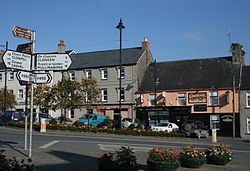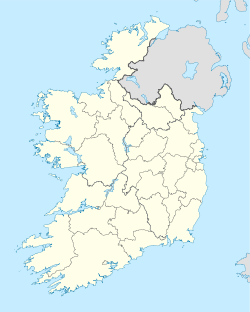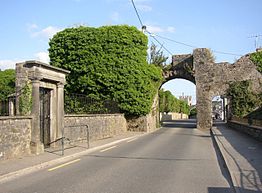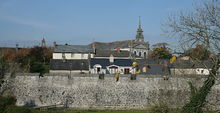- Fethard, South Tipperary
-
Fethard
Fiodh Ard— Village — Fethard village centre Location in Ireland Coordinates: 52°27′54″N 7°41′46″W / 52.465°N 7.696°WCoordinates: 52°27′54″N 7°41′46″W / 52.465°N 7.696°W Country Ireland Province Munster County South Tipperary Area – Total 2.21 km2 (0.9 sq mi) Elevation 69 m (226 ft) Population (2006)[1] – Total 1,374 Irish Grid Reference S207355 Historical populations Year Pop. ±% 1821 2,878 — 1831 3,405 +18.3% 1841 3,915 +15.0% 1851 2,767 −29.3% 1861 2,303 −16.8% 1871 2,106 −8.6% 1881 1,926 −8.5% 1891 1,607 −16.6% 1901 1,498 −6.8% 1911 1,473 −1.7% 1926 1,180 −19.9% 1936 1,112 −5.8% 1946 1,024 −7.9% 1951 984 −3.9% 1956 992 +0.8% 1961 962 −3.0% 1966 997 +3.6% 1971 1,064 +6.7% 1981 1,285 +20.8% 1986 1,391 +8.2% 1991 1,431 +2.9% 1996 1,397 −2.4% 2002 1,388 −0.6% 2006 1,374 −1.0% [2] Fethard (Irish: Fiodh Ard, meaning "high wood")[3][4] is a village in South Tipperary in Ireland. It is located 16 km (9.9 mi) east of Cashel on the Clashawley River where the R692, R689 and R706 regional roads intersect. It is in the barony of Middle Third, and is also a parish in the Roman Catholic Archdiocese of Cashel and Emly. In 2006, its' population was 1,374.[1]
Contents
Features
The village is remarkable for having been heavily fortified and completely surrounded by village walls as part of Edward I's policy of establishing fortified market village's. The village walls rise to a height of 25 feet (7.6 m) and can still be seen today. Most of the circuit survives, making Fethard the most complete medieval circuit in Ireland. Knockelly Castle, a well fortified tower house is one of many historical buildings in the area. The village is also internationally known in the Thoroughbred horse racing industry as the home of Coolmore Stud. There are also a number of horse-training stables in Fethard, notably that of Michael "Mouse" Morris, at Everardsgrange. McCarthy's Hotel is noted as a place to meet celebrities associated with the racing industry. This was the home of Dick McCarthy, noted professional jockey of the early 20th century who finished third in the Grand National at Aintree in 1929.
History
The story of Fethard begins in earnest with the coming of the Anglo-Normans to Ireland eight centuries ago. The low hill on which the village is sited may have been crowned by a church in the pre-Norman period, but there is no certain evidence that it was a place of settlement until around 1200 when it was chosen as the location of a major settlement by a Norman lord, almost certainly William de Braose who had been installed by King John in 1201 as the chief tenant of a very substantial territory encompassing most of the modern County Tipperary.
Fethard did not evolve slowly into a village in the aftermath of the Norman arrival; rather, it began its life as one. It was laid out systematically, with a clearly demarcated market area, a conveniently-located church and graveyard, and a regular pattern of streets. Its economy was nourished by the rich farmland in its vicinity; indeed, approaching the village today from Mullinahone, Moyglass, Cashel, Clonmel or Kilsheelan, one travels along roads that twist around fields which have been ploughed and grazed many times but which have hardly changed shape since the Middle Ages.
In addition to providing an infrastructure which would serve the village well, Fethard's founder acquired for it a charter bestowing on it the status of borough and endowing it with a constitution under the terms of which the village people, or burgesses, enjoyed such privileges as fixed annual rents, access to their own court, and set fines for all but the most serious of offences. The granting of charters was to some extent incidental to the economic health of the settlements, but the entitlements that went with the charters enticed rural folk from England and Wales to settle in Ireland, and thus the boroughs played a crucial role in the plantation of Anglo-Norman families in Ireland. There is no doubt that Fethard's medieval population was largely made up of people of rural origin from across the Irish Sea. Many of the village people may originally have come from William de Braose's vast estates in Wales.
Settlements with borough status were not guaranteed survival, not to mention prosperity. Disadvantageous sites, competition from larger and older settlements, and a failure to attract people in sufficient numbers contributed to the early stagnation of a number of boroughs. The foundation of Fethard proved to be a successful venture, thanks in part perhaps to William de Braose's energetic promotion of it, but other settlements in the area with borough status - Kiltinan and Lisronagh, for example - struggled to survive and are now places of comparatively little significance.
The village and lands of Fethard passed out of William de Braose's hands in 1208 following a dispute he had with King John. In 1215 the Crown granted Fethard to the archbishops of Cashel, and it remained part of the archiepiscopal estates until the 16th century when the village people stopped paying rents to Cashel. By the time the archbishops inherited Fethard the village's great parish church had been built, and William, following the custom of the day, had granted the revenue which was owed to the church from the surrounding lands to a religious house, in this case the Hospital of St. John the Baptist in Dublin. The Hospital seems to have held this revenue until the early 14th century when it was passed on by the Prior to the archbishops of Cashel.
The 13th century was a period of prosperity for Fethard, as indeed it was for other village's in Anglo-Norman Ireland. Goods sold in Fethard around the end of the century included silk, wine skins, sea-fish, coal, nails, timbers and salt. The Augustinian Friars came to Fethard at the start of the following century and established a monastery outside the village on one and a half acres of land; the Friars had actually acquired this land without the king's permission, but following an investigation they were formally pardoned by the king for their breach of procedure.
Life within and beside the village may have been comparatively stress-free in the 13th century, but the village's rural hinterland was not entirely safe for travellers. In the middle of the century, for example, the woods of Thomas de St. Aubin, located near the village, needed to be cleared because merchants on their journey to Fethard had been robbed and even killed.
One effect of the increasing lawlessness of the Norman colony in Ireland towards the end of the 13th century - a well-documented phenomenon that owed much to the aggression of the native Irish - was the building of Village Walls at places like Fethard.
Wall-building required finance, and this was usually generated by taxes. A Village Wall had, therefore, an impact on the lives of village people beyond simply providing security for their settlement. Whatever the means of raising money, the imposition of taxes or tolls for the purpose of walling needed approval from the king (or, later in the Middle Ages, from parliament), and a limit was put to the time in which money could be collected for the task.
The first reference to the walling of Fethard comes in 1292 when the king allows money levied over seven years from items sold in the village to be used by the burgesses for "the inclosing of their vill and the greater security of Ireland". A record of money still being collected in the early 14th century suggests a further grant after the expiry of that of 1292, but details of that have not survived.
Rarely in medieval Ireland was a single murage grant sufficient to fully enclose a village. In 1375-6 another grant, this time for ten years, was issued for Fethard, and this time stone walls were specified, which may suggest that the earlier village defences were walls of earth and timber, not of stone. Further murage grants - two, possibly three - are known from the 15th century.
When money was first made available for the walling of Fethard the village was probably somewhat smaller than the walled village we know today. Study of the village plan and close examination of the fabric of some of the village's buildings reveals the probable outline of the settlement founded by William de Braose. Clearly much of the land on the north and west sides of the present walled area was only taken into the village at the time of the 15th century murage grants.
Extensive building activity inside the village shows that Fethard was a strong and fairly prosperous place in the late Middle Ages. Its strategic importance is perhaps reflected in the fact that from the late 15th century Earls of Ormond were attending courts held in Fethard, and many Ormond ordinances were issued from here.
The village received a royal charter from Edward VI in 1552-3, allowing it a corporation in perpetuity, composed of one Sovereign, one Provost, Burgesses and inhabitants. The sovereign and provost, elected annually, were empowered to deal with all matters of law within the village. The freedom of the village to pursue its own affairs without fear of interference from the Crown came with an annual rent of 11 marks to the king. That the corporation successfully ran the village for the following half-century is indicated in the next royal charter, issued in 1608.
The key figure in the attainment of this second charter was Sir John Everard. In the 15th century the Everard family came to real prominence in Fethard's history, and documents record the extent of the family's property in the village during the 15th, 16th and 17th centuries. John Everard, Sir John from 1605, was educated as a lawyer, and for a time he served the Butler clan and even the Earl of Ormond. His performances as a justice in the Earl's liberty of Tipperary were rewarded with an appointment by Elizabeth I as Second Justice of the Queen's Bench in Ireland in 1602. Although the Everards were Catholic, and remained so, Sir John pledged allegiance to the Crown, and when he surrendered all his property to the Queen in 1607, it was immediately granted back to him. Sir John's good favour with the Crown was instrumental in securing the new charter for Fethard in 1608. In this charter the village was described as "a place of strength surrounded with a fair strong wall," and under its terms the Corporation was renewed and enlarged, and was endowed with such liberties and privileges as were needed to draw more people to the village and to increase its trade and commerce.
The Corporation was directed to build "a Tholsel (common Hall) for assemblies". In 1612 James I sanctioned the building by Sir John's grandson, another Sir John, of two almshouses, one on the south of the church for men, and one on the north of the church for women. The Everard family also erected a substantial house for itself in the village. Improvements to the village were not confined to individual buildings: the south side of the Main Street was actually rebuilt during this period, and the market place was thus widened.
A few decades after the charter had brought so many positive changes, Fethard came face-to-face with two of the 17th century's most destructive agencies, the armies of Lord Inchiquin and Oliver Cromwell. Inchiquin had already attacked Cashel with relentless ferocity, and when news of that bloodbath reached Fethard its citizens submitted to him. Three years later, in 1650, Cromwell marched on Fethard on his way to take Kilkenny, and in a letter to the Speaker of the House of Commons in London he described the village "as having a very good wall with round and square bulwarks, after the old manner of fortification". He further commented that he stationed his troops "in an old abbey in the suburbs", which is the Augustinian Friary. Terms of surrender were agreed.
The village may have survived the crises of the mid-17th century, but it entered the 18th century in a state of decay, and visitors invariably described it as run-down. The Corporation Books tell us that in 1718 no less than 56 persons had houses with dangerous chimneys.[5] It was during this period that the Everard family's close involvement with Fethard came to a rather tame end. The last Baronet, Sir Redmond Everard, who lived in France, mismanaged the estate. In 1752 the old Everard properties in Fethard were sold to a Mr Barton, a wine merchant from Bordeaux, and he set about replacing the old Everard mansion with a new house, which in turn became a military barracks early in the 19th century. The present Catholic church in Fethard, built in 1818-19, also occupies a site formerly owned by the Barton family.
Destruction of the medieval fabric of the village was an unfortunate feature of the 19th century. By the start of the present century all but one of the village gates had been demolished, while the Augustinian Friary, in private ownership between the late 16th century and the mid-1820s, had its west tower removed in 1835.
Famous People
Fethard, over the years, has seen some of its residents reach stardom, both nationally and internationally. Notable ambassadors include Mr. John Magnier who owns the world-famous Coolmore Stud based in Fethard. Michael 'Mouse' Morris is an Irish racehorse trainer who's attributes include Buck House in the 1983 Supreme Novices' Hurdle and the 1986 Queen Mother Champion Chase; and War Of Attrition in the 2006 Cheltenham Gold Cup. Eoghan O' Neill, bass guitarist with Irish Celtic/Jazz band 'Moving Hearts' is originally from Fethard and has captivated international audiences with his masterful playing and musical prowess. He is also an in-demand session player who has recorded with musicians such as Chris Rea and Donal Lunny. Archbishop John J. Cantwell attended the Patrician Brothers Monastery National School, and the nearby Classical Academy.[6] John Butler, 12th Baron Dunboyne was buried in the Augustinian friary here. Ailish O'Connell(known to sign the odd autograph) is also a famous member of the Fethard community village people!
Sport
Fethard is well-known for being a village of sport, and is very successful in various different fields of sport especially when one measures the village's achievements in relation to the village's size.
- St. Patricks Cricket Club was founded in 1899. The club currently fields 1 senior team, 2 junior teams as well as various underage teams. St. Patrick's play their games in the Ponseby Memorial Oval located between Fethard and Killusty.
- the village has one of three 3 Rugby league clubs in the country. The Fethard Knights play in the East Munster Conference and their home ground is the Barrack Field, located near the village centre. The coaching staff is made up Sean Devaney, Charlie Hansen and Roy Skipton.
- Fethard GAA plays in the community sports field.
See also
- List of villages in Ireland.
- Fethard-on-Sea is also the name of a coastal village in County Wexford, Ireland, on the Hook peninsula.
References
- ^ a b "Census 2006 – Volume 1 – Population Classified by Area" (PDF). Central Statistics Office Census 2006 Reports. Central Statistics Office Ireland. April 2007. http://www.cso.ie/census/documents/census2006_volume_1_pop_classified_by_area.pdf. Retrieved 2011-06-19.
- ^ http://www.cso.ie/census and www.histpop.org. Figures include environs of Fethard. For a discussion on the accuracy of pre-famine census returns see JJ Lee “On the accuracy of the pre-famine Irish censuses” in Irish Population, Economy and Society edited by JM Goldstrom and LA Clarkson (1981) p54, and also “New Developments in Irish Population History, 1700-1850” by Joel Mokyr and Cormac Ó Gráda in The Economic History Review, New Series, Vol. 37, No. 4 (Nov., 1984), pp. 473-488.
- ^ A. D. Mills, 2003, A Dictionary of British Place-Names, Oxford University Press
- ^ "Fiodh Ard/Fethard". Placenames Database of Ireland. Government of Ireland. http://www.logainm.ie/47849.aspx. Retrieved 20 June 2011. (archival records)
- ^ Michael O'Donnell, Tipperary Historical Journal (1988), pp. 22-38.
- ^ http://www.cshm.org/jjcantwell.html
External links
Categories:- Parishes in Archdiocese of Cashel and Emly
- Civil parishes of South Tipperary
- Villages in South Tipperary
Wikimedia Foundation. 2010.





